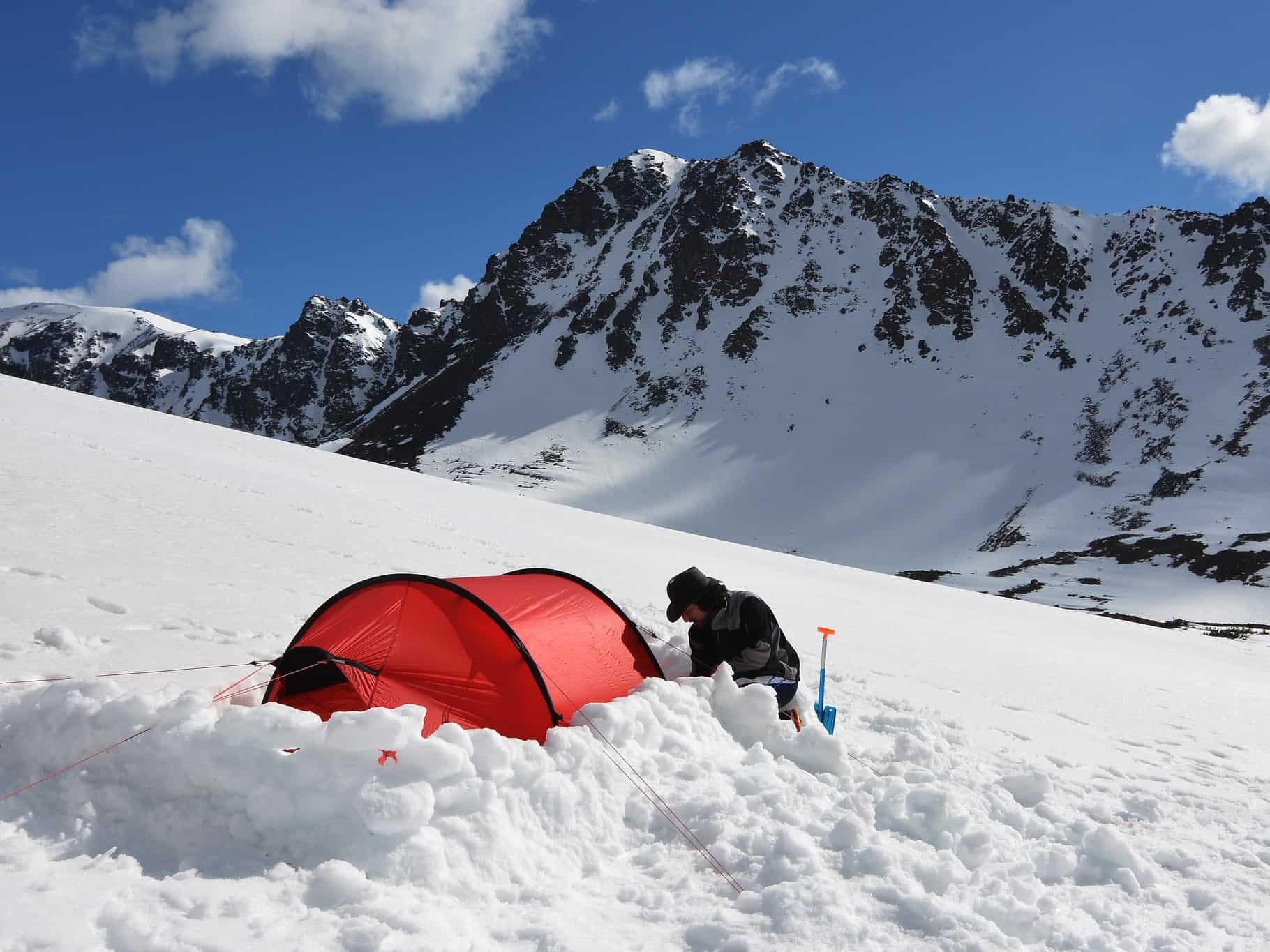Last updated on February 13th, 2023 at 05:45 pm
Camping in the cold provides many benefits including incredible peace and privacy. However, winter camping brings many challenges, including staying warm. For this reason, you may be wondering, “How do I make my tent warmer?”
Here we break down crucial tips on how to make your tent warmer during cold weather camping. Whether you’re planning a trip or at the campsite, patching holes, hot water bottles, heaters, and elevating your bed are just a few ways to keep warm.
1. Inspect Your Tent
Firstly, this one may seem obvious, but if you miss a hole in your tent, cold air can seep through. When I find myself wondering, ‘how do I make my tent warmer,’ my first step is to always double check everything for rips where air is getting through.
Be sure to not only check for holes, but also loose seams.
Often, seams can loosen or tear at their edges, especially if your tent is older.
Do a mock tent setup at home in your living room or back yard to inspect everything.
Take a close look at all of your edges, and patch things up before setting out.
Most tents come with a repair kit. However, if you have the time, invest in a seam seeler like Gear Aid Seam Grip.
2. Reinforce Your Rainfly
Next, while your rainfly protects you from precipitation, it is a loose covering, and a big area from which warm air can escape. By adding another layer over your rainfly, you can help keep cold air out.
Try adding a tarp over your rainfly to act as another piece of insulation.
Consider bringing a lightweight tarp from a home improvement store.
Calculate or measure the height of your tent walls to the peak on all sides.
Purchase a tarp that is capable of fitting snuggly against your rainfly/tent roof plus extra length to anchor using tent stakes into the ground.
You may also want to look into a waterproof tarp if you’ll be in snow, or wet and rainy conditions.
We discourage cotton duck drop clothes, as the extra weight may buckle and compromise your tent’s poles. Plus, cotton will absorb rain and snow.
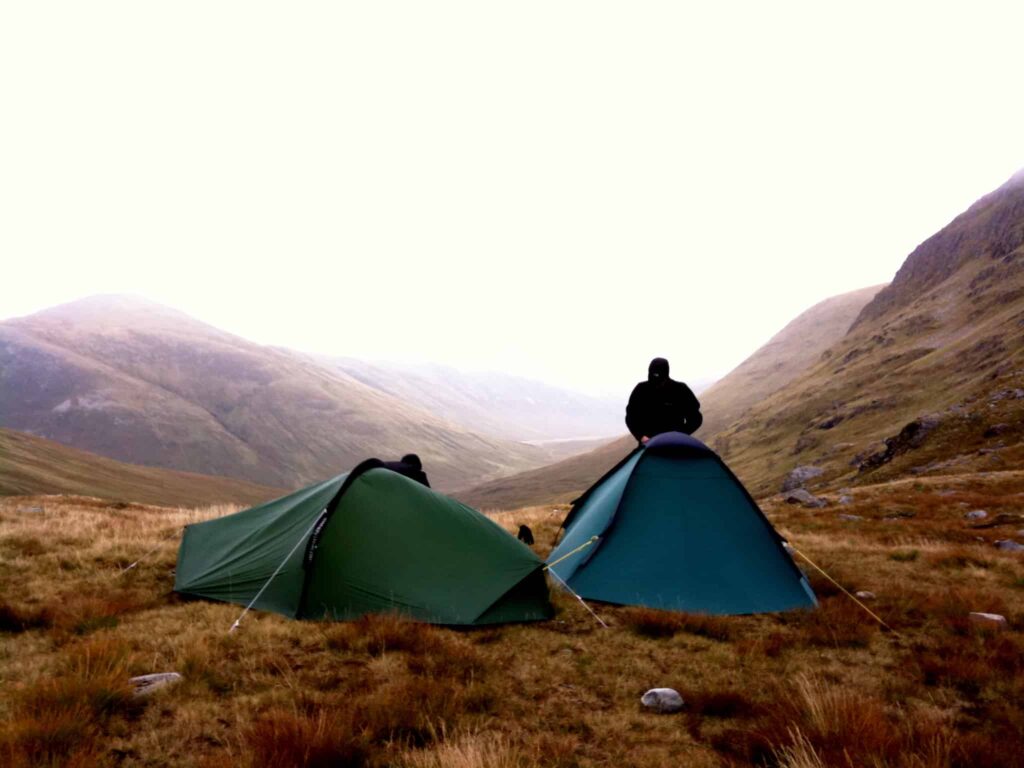
3. Choose Your Site Wisely
Additionally, choosing your campsite wisely can make a huge difference in your level of warmth.
For instance, choose a site that has natural windbreaks and cover.
Here are some examples of windbreaks and natural coverage to set up by:
- Large rocks or boulders
- Large shrubs
- Bases of hills
- Dense tree linings, or even fallen logs
You can also create a lean-to with a tarp to help block out cold wind from hitting your tent.
4. Build a Snow Fortress
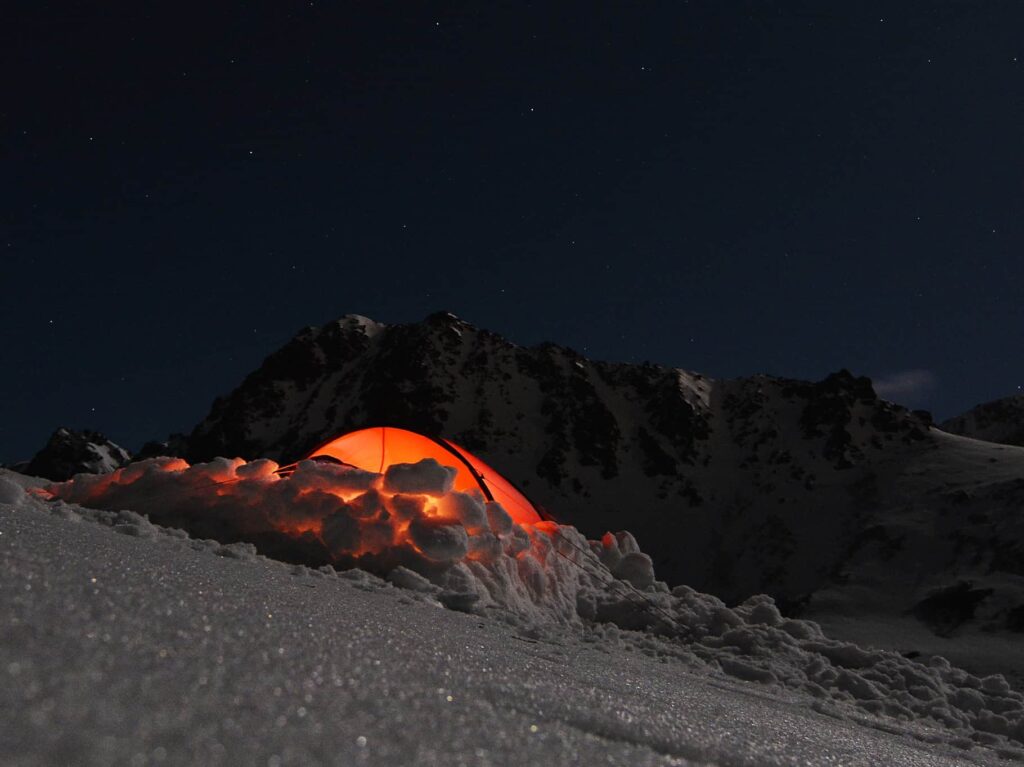
This may seem counter-intuitive, but insulating your tent with snow can help keep you warmer! For instance, Igloos provide a very adequate block from the cold.
Furthermore, skilled survivalists know that a quick and safe shelter can be made by digging into deep snow when hiking in frigid regions.
While snow is cold, packing it up around your tent can act as a windbreak.
It can also help keep heat trapped inside your tent, since it is adding another barrier against the outside air.
However, be conscious to keep ventilation for any heaters and for condensation to escape.
5. Vent Your Tent
Moisture is your enemy in a winter camp. For instance, moisture can seep into clothing and sap body heat creating a dangerous situation. And we realize ventiliation isn’t the first thing you think when the topic of ‘how do I make my tent warmer’ comes up. However, it’s a key component to maintaining a warm tent.
When we breathe, we release moisture into the air. In a sealed tent, this can cause condensation to develop overnight on your clothes and inside your tent.
To avoid this, you actually want to vent your tent. If your tent has vents, you need to open them so that moisture can escape.
Finally, if you’ve set up camp behind a wind break, be sure to situate your vent windows downwind so any gusts hit solid tent wall and not an open window.
6. Layer Up
Additionally, when it comes to clothing, layers are essential.
You want to focus on having a base layer, a middle layer, and a shell (top) layer. This can consist of thermals, long underwear, sweaters, fleece, and outdoor puff jackets or coats.
Choose materials the wick moisture. Fleece and wool are the best and quickest drying.

You can also layer socks. Ideally, avoid cotton and choose Merino wool, which wicks away moisture.
Along with this, it’s equally important to make sure you aren’t too hot.
Sweat cools as it dries, which can lead you to becoming even colder later. Plus, once materials like clothes become damp, it’s tough to get them dry again.
If you do get sweaty, remove your base layers as soon as possible. When you get too hot, you can simply remove a layer.
Finally, wear a winter hat that covers your ears, since heat escapes from your head.
7. Get a Halogen heater
Another great option is a heater. Tent heaters can get a bad rap due to safety concerns; however, electric heaters are safer than gas.
Because they are electric, halogen heaters eliminate the risk of carbon dioxide poisoning from combustion and the asphyxiating propane gas from propane heaters and stoves.
Electric heaters can heat a larger tent quickly, which is a lifesaver in below freezing conditions.
However, with this option, you will need an electric power source, such as a generator.
Of course, any heater should be turned off before sleep.
They should also be kept away from flammable materials on a stand or flat surface, which is difficult in a polyester tent.
Additionally, it also shouldn’t be left unattended.
8. Elevate Your Bed
Another great trick for warmth is to elevate your bed off the ground. By adding a sleeping pad between your tent and the floor, you’ll insulate your body from the freezing ground. Check out the best options in our Best Camping Mattress for Bad Back post.
However, an air mattress can actually make things colder! The air in your mattress will adjust to the temperature of the ground, bringing cold into your tent.
Luckily, if an air mattress is all you have, which is likely if you’re backpacking, add a layer of brush between the mattress and the ground.
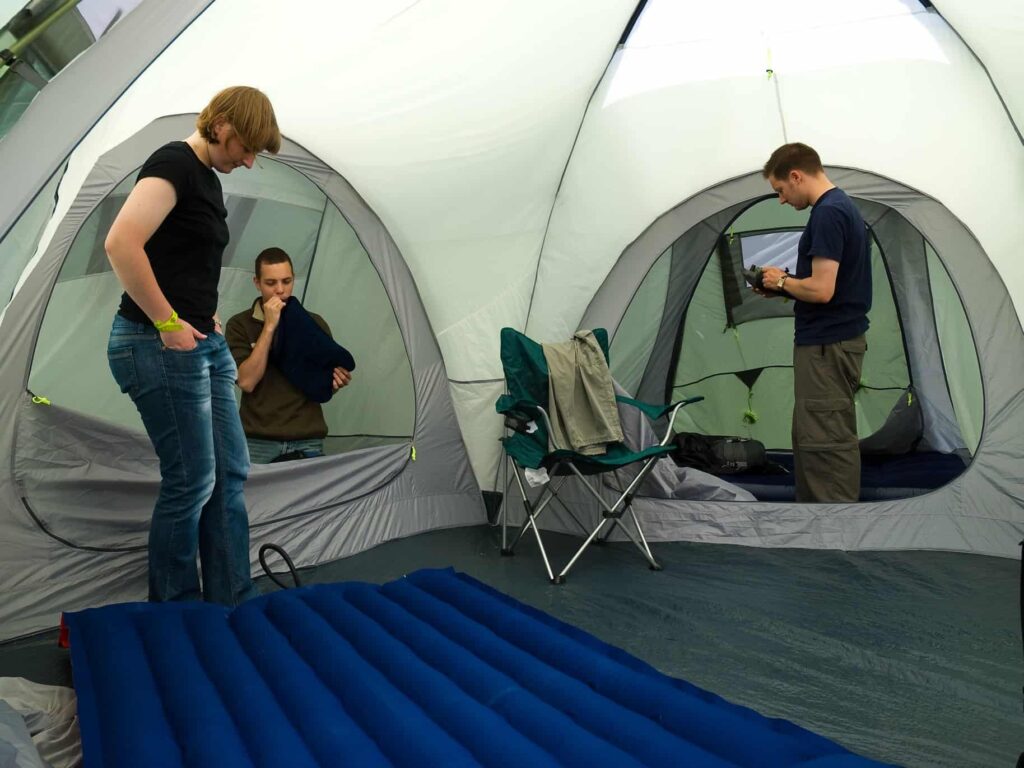
9. Hot Rocks
In addition, if you heat rocks with your fire, they will give off radiant heat. You can then place them inside your tent and by your sleeping back to gather in their warmth.
Let your rocks heat for about an hour, then cool for a bit before placing them inside.
However, do not heat wet river rocks, as they can an will explode if they get too hot.
10. Bring a Portable Camp Heater
Portable camp heaters are a good bet for heating your tent quickly. They typically run on propane or butane, so you won’t need an electrical source.
However, remember that gas heaters give off fumes that can be toxic if trapped. Make sure your tent is well-ventilated before using a camp heater.
Also, don’t use the heater for extended periods, and always turn it off before you go to sleep.
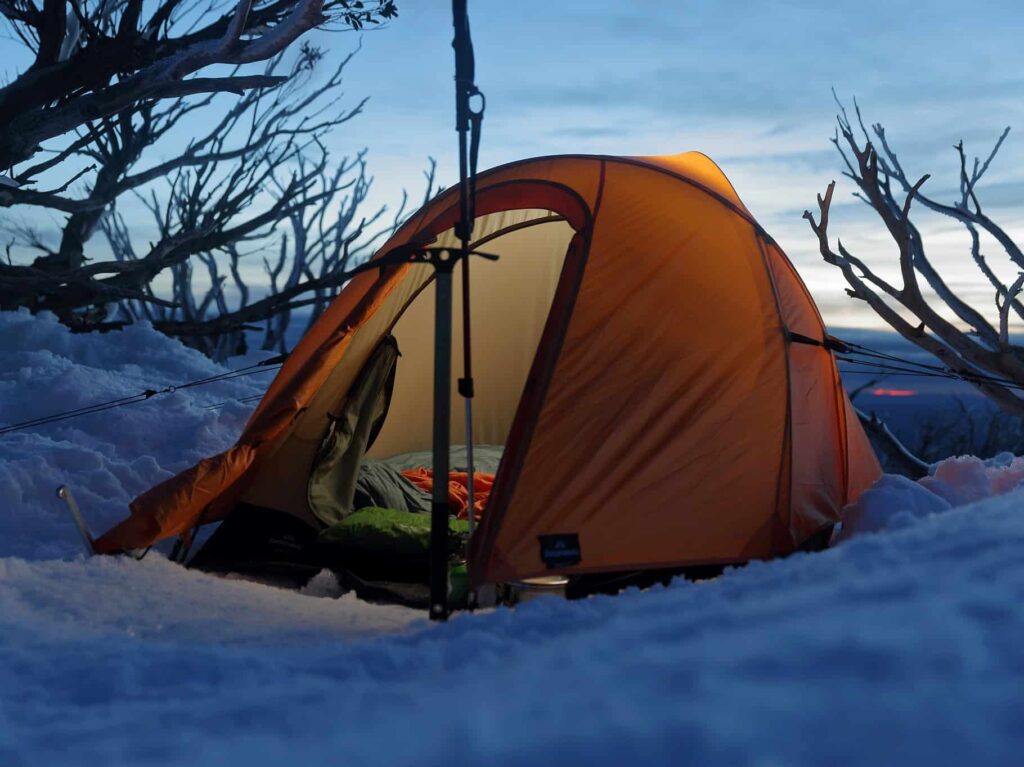
11. Eat a Good Dinner
In addition, you actually have an internal furnace you can feed to keep warm. That’s right, digestion burns calories, which are actually units of energy that give off heat. This is the most fun and easy way to satisfy the question, ‘how do I make my tent warmer.’
When you eat a large meal, your metabolism kicks into high gear, which generates more heat. Because of this, you should eat a large, carb-heavy meal to help keep you warm throughout the night. We’ve found the best tools for cooking your camp meals in our Best Camping Stove post.
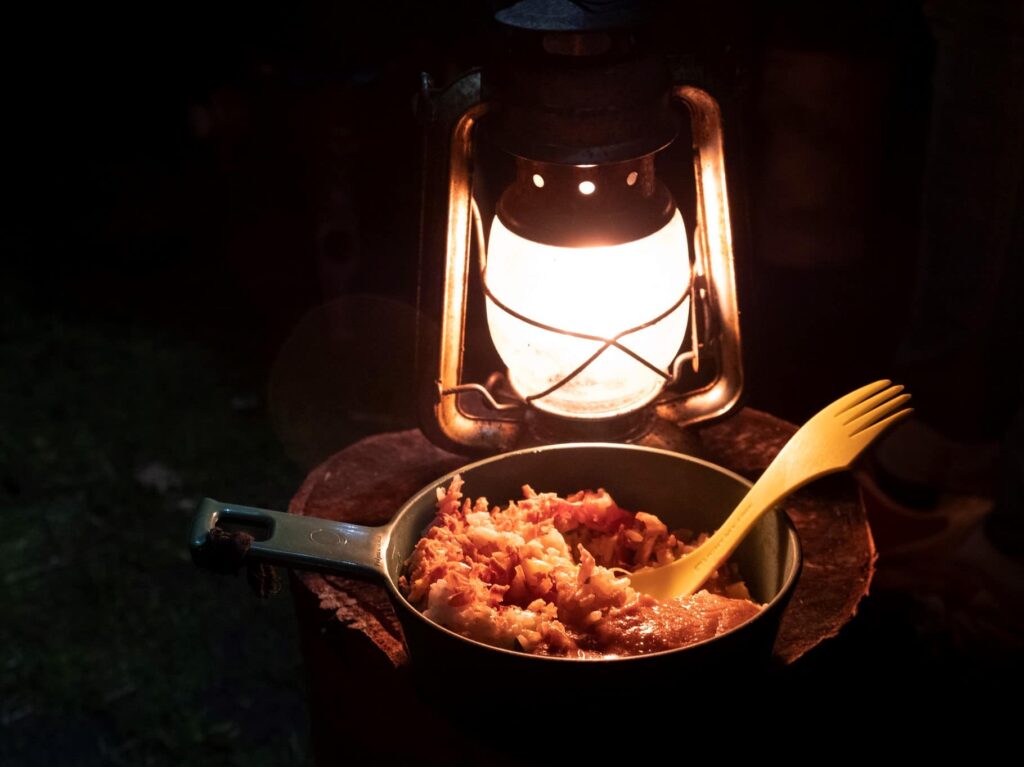
I recently did an experiment. I stopped eating past 6 pm in the humid suffocating summer months in our home with no a/c in the bedroom.
The days where I didn’t eat late into the evening, I was comfortable and slept great, I even used a comforter.
Whereas, the nights I ate a calorie and carb-dense meal around 9 pm, I ran so hot I had to move downstairs closer to a/c.
12. Pack a Hot Water Bottle
It sounds simple, but it works! A water bottle filled with hot water can be slipped inside your sleeping bag to add more heat.
This is an excellent option when there is plenty of snow around to melt and fill a bottle.
You will have to heat the water over a stove, and it won’t last longer than a night, but it’s an easy thing to bring on any trip.
Also be sure to make sure the bottle is tightly sealed and that you melt the water outside of the tent to avoid condensation. We’ve found the best way to boil water on the trail in our Best Camping Teapot for Backpackers post.
13. Always Bring Hand Warmers
A pair of disposable hand warmers is always an excellent tool to keep in your winter pack.
While the duration of warmth varies with certain brands, many will do for a few hours in a pinch.
You can slip these inside your mittens, socks, and even your sleeping bag if need be, making them multi-functional.
It also helps to have these going in your mittens before bedtime so you don’t go to bed looking for warmth that you won’t find.
14. Get a Warmer Sleeping Bag
There’s nothing better than sliding into a fluffy, warm sleeping bag during your winter camp, one that is rated to keep you comfortable. However, not all sleeping bags are created equal in terms of warmth and insulation.
Choosing a temperature-appropriate sleeping bag can offer you adequate protection for your trip.
Look for models that can keep you insulated even in below-freezing temperatures. This information should be shown on the label.
Standard, low-end sleeping bags designed for summer may leave you shivering, which is something you definitely want to avoid.
Gather Your Gear and Head Out
Snuggling up by your campfire in the crisp winter air can be incredibly peaceful. But what happens when you have to step away from your fire and head to your tent? Many find that those crisp temperatures can become unbearable!
Staying warm and getting a good night’s sleep during your winter camping trip is essential. After all, base comforts help keep you energized and vibrant during your adventure!
Fortunately, with minimal effort and good planning, staying warm on a cold weather camping trip is easy. With these simple tips, you can ensure you stay warm and dry in your tent. So whether you’re planning a winter trip, or are already on the road, keep them handy.
About the Author
Todd Alexander
Title Image Credit, How do I Make my Tent Warmer: Paxson Woelber | (source) | Attribution 2.0 Generic (CC BY 2.0) — reduced file size and image
Image Credit 1, How do I Make my Tent Warmer: John Keane | (source) | Attribution-ShareAlike 2.0 Generic (CC BY-SA 2.0) — reduced file size and image
Image Credit 2, How do I Make my Tent Warmer: Paxson Woelber | (source) | Attribution 2.0 Generic (CC BY 2.0) — reduced file size and image
How do I Make my Tent Warmer, Image Credit 3: Sterling College | (source) | Attribution 2.0 Generic (CC BY 2.0) — reduced file size and image
How do I Make my Tent Warmer, Image Credit 4: Jake Archibald | (source) | Attribution 2.0 Generic (CC BY 2.0) — reduced file size and image
Image Credit 5, How do I Make my Tent Warmer: Ed Dunens | (source) | Attribution 2.0 Generic (CC BY 2.0) — reduced file size and image
Image Credit 6, How do I Make my Tent Warmer: Kitty Terwolbeck| (source) | Attribution 2.0 Generic (CC BY 2.0) — reduced file size and image

